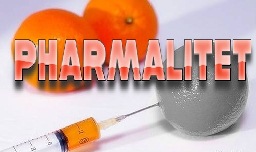Tuesday, December 31, 2013
Happy new year! LoL
Labels:
cognitive,
deconstruction,
masterpiece of the day,
nice idea,
real science,
video
Monday, December 30, 2013
Real values

Labels:
masterpiece of the day,
nice idea,
real science
Soliaris - the masterpiece
Солярис не вошедшие сцены
Labels:
another magic cure,
chaos,
cognitive,
deconstruction,
magic,
masterpiece of the day,
nice idea,
paradigm,
real science,
video
Sunday, December 29, 2013
Russia in 2014...
Labels:
chaos,
deconstruction,
failure,
future foresight,
macro economy,
paradigm,
politics,
real science,
shit of the day,
video
Saturday, December 28, 2013
Top 2012 pharmaceuticals
Labels:
another magic cure,
Big Pharma,
bubble,
deconstruction,
nice idea,
numbers,
real science
Targeted failure of the week. Post No 129. AXL1717
Axelar AB (Solna, Sweden) said twice-daily oral AXL1717 missed the primary endpoint of improving the 12-week progression-free survival (PFS) rate vs. docetaxel in the Phase II AXL-003 trial to treat non-small cell lung cancer (NSCLC) (25.9% vs. 39%, p=0.19). AXL1717 also missed the secondary endpoints of improving median overall survival (OS) (7.52 vs. 9.41 months, p=0.91) and PFS (2.83 vs. 2.85 months, p=0.32) vs. docetaxel. Axelar said some early episodes of neutropenia in the AXL1717 arm developed into serious events, some of which were fatal.
 In April, Axelar reported interim data from the trial showing that AXL1717 led to a "similar" 12-week PFS rate as docetaxel, but the company declined to disclose details. The open-label, international trial enrolled 99 evaluable patients with previously treated, locally advanced or metastatic NSCLC.
In April, Axelar reported interim data from the trial showing that AXL1717 led to a "similar" 12-week PFS rate as docetaxel, but the company declined to disclose details. The open-label, international trial enrolled 99 evaluable patients with previously treated, locally advanced or metastatic NSCLC.
On a conference call to discuss the data, the company said a "rational way forward" would be to evaluate AXL1717 as third-line treatment of NSCLC. Axelar said it is "planning future studies in parallel with ongoing partner discussions," but could not be reached for details. AXL1717 is an oral small molecule insulin-like growth factor-1 (IGF-1) receptor (IGF1R; CD221) inhibitor, though the company said there is evidence that AXL1717 also suppresses tumor cell division by arresting cells in mitosis.
Friday, December 27, 2013
Vibrations...
Labels:
cognitive,
deconstruction,
music of the week,
nice idea,
real science,
video
Russia - game over!
Labels:
chaos,
deconstruction,
depression,
future foresight,
nice idea,
paradigm,
politics,
real science,
shit of the day,
video
Thursday, December 26, 2013
Russian technique.

Labels:
chaos,
cognitive,
deconstruction,
failure,
masterpiece of the day,
nice idea,
real science,
shit of the day
Wednesday, December 25, 2013
Drop in UK death rates from cancer
 Research is the key cause behind the 22% drop in UK death rates from cancer
reported between 1990 and 2011, says new research.
Research is the key cause behind the 22% drop in UK death rates from cancer
reported between 1990 and 2011, says new research.
In 1990, 220 in every 100,000 people died of cancer ,but this figure fell
to 170 per 100,000 in 2011, due to improved knowledge about preventing the
disease, surgical techniques, precisely-targeted radiotherapy and more effective
drugs all boosting the outcome for patients
Big Pharma's Top 10 Settlements of Shame for 2013
Labels:
Big Pharma,
bubble,
chaos,
cognitive,
deconstruction,
depression,
failure,
nice idea,
numbers,
paradigm,
politics,
real science,
shit of the day
Tuesday, December 24, 2013
Monday, December 23, 2013
Quote of the day

Labels:
another magic cure,
cognitive,
Death Valley,
deconstruction,
evidence based medicine,
future foresight,
masterpiece of the day,
nice idea,
paradigm,
quote of the day,
real science,
semantic
Sunday, December 22, 2013
Saturday, December 21, 2013
Friday, December 20, 2013
Well, really BIG deals for Big Pharma!
The pharmaceutical giant AstraZeneca said on Thursday that it would pay up to $4.1 billion to acquire Bristol-Myers Squibb’s stake in an alliance to jointly develop diabetes drugs.
Labels:
Big Pharma,
bubble,
deconstruction,
evidence based medicine,
investment,
numbers,
real science
Thursday, December 19, 2013
New Medicines Emerge, but Few Blockbusters
Labels:
Big Pharma,
bubble,
deconstruction,
evidence based medicine,
investment,
nice idea,
numbers,
paradigm,
real science
Wednesday, December 18, 2013
Targeted failure of the week. Breast Cancer: Adding Avastin Boosts Toxicity
Labels:
Big Pharma,
bubble,
deconstruction,
depression,
evidence based medicine,
failure,
paradigm,
real science,
shit of the day,
targeted failure
When erection is painfull...
 For parents who worry those ADHD pills may not be appropriate, here is another reason for concern – the FDA has just issued a notice saying methylphenidate products, which include Ritalin and Concerta, may cause prolonged and sometimes painful erections known as priapism. If there is any good news it would be this sort of thing is rare. Still, who wants to learn the hard way? Pardon the pun.
For parents who worry those ADHD pills may not be appropriate, here is another reason for concern – the FDA has just issued a notice saying methylphenidate products, which include Ritalin and Concerta, may cause prolonged and sometimes painful erections known as priapism. If there is any good news it would be this sort of thing is rare. Still, who wants to learn the hard way? Pardon the pun.
Labels:
bubble,
chaos,
cognitive,
deconstruction,
evidence based medicine,
failure,
shit of the day
Tuesday, December 17, 2013
Monday, December 16, 2013
Sunday, December 15, 2013
Eskobar...
Labels:
another magic cure,
deconstruction,
evidence based medicine,
music of the week,
real science,
video
Saturday, December 14, 2013
Depeche
Labels:
cognitive,
deconstruction,
masterpiece of the day,
music of the week,
real science,
semantic,
video
Friday, December 13, 2013
Your Vote Counts: Who Is the Worst Biotech CEO of 2013?
 What a nice approach! The next to come should be:
What a nice approach! The next to come should be:- the worst targeted drug
- the worst Big Pharma Company
- the worst indication (just like bent penis or painful sex)
Labels:
Big Pharma,
deconstruction,
failure,
nice idea,
real science,
targeted failure
Avastin - bad news again
Patients treated with chemotherapy plus trastuzumab (Herceptin) had 92% iDFS with or without the bevacizumab. Subgroup analysis did not identify any group of patients that benefited from the addition of the angiogenesis inhibitor.
Labels:
Big Pharma,
bubble,
deconstruction,
evidence based medicine,
failure,
paradigm,
real science,
targeted failure
Thursday, December 12, 2013
Tuesday, December 10, 2013
Spokojno zhgem tanki
Labels:
another magic cure,
cognitive,
Death Valley,
deconstruction,
evidence based medicine,
future foresight,
magic,
masterpiece of the day,
nice idea,
Partisan of Death Valley,
real science,
video
Monday, December 9, 2013
TV food

Labels:
cognitive,
Drug Delivery,
evidence based medicine,
nice idea,
paradigm,
politics,
real science
Sunday, December 8, 2013
Saturday, December 7, 2013
Depeche again
Bent penis? 5%of U.S. men are affected! Not a problem anymore!
Post-modern Health problems - not a joke!!!
WASHINGTON (AP) -- The Food and Drug Administration on Friday approved the first drug to treat an unusual condition that causes painful, curved erections in men.
FDA says the injectable drug is the first non-surgical treatment for the disease.
Drugmaker Auxilium Pharmaceuticals estimates 5 percent of U.S. men are affected. - It sounds like an epidemic!
Xiaflex was previously approved in 2010 to treat a hand disease that interferes with patients' ability to straighten their fingers. The FDA said in its release that Xiaflex is believed to treat Peyronie's disease by breaking down collagen plaque that builds up in the penis and causes the deformity.
The FDA said it is limiting distribution of the drug to certified physicians and health care centers due to serious potential side effects, including injury of the penis. Health care professionals must enroll and complete a training program before prescribing the drug.
The FDA approved Xiaflex for its new use based on two studies of 832 men with Peyronie's disease. Patients received up to eight injections of the drug and were then followed for a year to see if their condition improved. Patients who received the drug reported significantly fewer problems than those who received a dummy injection.
The drug was developed by BioSpecifics Technologies Corp. of Lynbrook, N.Y., and submitted to the FDA by Chesterbrook, Pa.-based Auxilium Pharmaceuticals Inc.
Shares of Auxilium rose $1.80, or 9.3 percent, to $21.13 in afternoon trading.
Friday, December 6, 2013
Thursday, December 5, 2013
To win. Pereslegin's book. Highly recommended. As usual...
Labels:
another magic cure,
chaos,
cognitive,
deconstruction,
future foresight,
masterpiece of the day,
nice idea,
paradigm,
politics,
real science
Wednesday, December 4, 2013
Ukraine (and Belarus) will be free! The sober point of view!
Labels:
chaos,
cognitive,
deconstruction,
failure,
future foresight,
masterpiece of the day,
nice idea,
politics,
real science,
video
Authorship For Sale. Why not?
Very interesting Reading:
 "There are some authors who don't have much use for their papers after they're published, and they can be transferred to you," a sales agent for a company called Wanfang Huizhi told a Science reporter posing as a scientist. Wanfang Huizhi, the agent explained, acts as an intermediary between researchers with forthcoming papers in good journals and scientists needing to snag publications. The company would sell the title of co–first author on the cancer paper for 90,000 yuan ($14,800). Adding two names—co–first author and co–corresponding author—would run $26,300, with a deposit due upon acceptance and the rest on publication. A purported sales document from Wanfang Huizhi obtained by Science touts the convenience of this kind of arrangement: "You only need to pay attention to your academic research. The heavy labor can be left to us. Our service can help you make progress in your academic path!"
"There are some authors who don't have much use for their papers after they're published, and they can be transferred to you," a sales agent for a company called Wanfang Huizhi told a Science reporter posing as a scientist. Wanfang Huizhi, the agent explained, acts as an intermediary between researchers with forthcoming papers in good journals and scientists needing to snag publications. The company would sell the title of co–first author on the cancer paper for 90,000 yuan ($14,800). Adding two names—co–first author and co–corresponding author—would run $26,300, with a deposit due upon acceptance and the rest on publication. A purported sales document from Wanfang Huizhi obtained by Science touts the convenience of this kind of arrangement: "You only need to pay attention to your academic research. The heavy labor can be left to us. Our service can help you make progress in your academic path!"
And the $14,800 is not a big deal for serious researchers!
And the $14,800 is not a big deal for serious researchers!
Labels:
deconstruction,
future foresight,
nice idea,
numbers,
real science
Tuesday, December 3, 2013
Monday, December 2, 2013
Sunday, December 1, 2013
Saturday, November 30, 2013
Depeched video of the week
Labels:
another magic cure,
cognitive,
music of the week,
real science,
video
Friday, November 29, 2013
Yanek makes history!
Labels:
another magic cure,
cognitive,
deconstruction,
evidence based medicine,
future foresight,
masterpiece of the day,
music of the week,
nice idea,
paradigm,
politics,
real science
Thursday, November 28, 2013
Pourquoi pas
Labels:
another magic cure,
cognitive,
deconstruction,
evidence based medicine,
future foresight,
magic,
masterpiece of the day,
music of the week,
nice idea,
Partisan of Death Valley,
real science,
video
Wednesday, November 27, 2013
The Masterpiece!
Labels:
another magic cure,
cognitive,
deconstruction,
evidence based medicine,
future foresight,
magic,
masterpiece of the day,
nice idea,
paradigm,
Partisan of Death Valley,
real science,
semantic,
video
Tuesday, November 26, 2013
Theranostics - WTH? Another magic cure?
Labels:
another magic cure,
Big Pharma,
chaos,
cognitive,
deconstruction,
future foresight,
shit of the day,
targeted failure,
video
Be happy!
Жила-была бедная еврейская семья.
Детей было много, а денег мало.
Бедная мать работала на износ – готовила, стирала, и орала, раздавала подзатыльники и громко сетовала на жизнь.
Наконец, выбившись из сил, отправилась за советом к раввину: как стать хорошей матерью?
Вышла от него задумчивая. С тех пор ее как подменили.
Нет, денег в семье не прибавилось. И дети послушнее не стали.
Но теперь мама не ругала их,а с лица ее не сходила приветливая улыбка.
Раз в неделю она шла на базар, а вернувшись, на весь вечер, запиралась в комнате.
Детей мучило любопытство. Однажды они нарушили запрет и заглянули к маме.
Она сидела за столом и …пила чай со сладким цимесом!
"Мама, что ты делаешь? А как же мы?"- возмущенно закричали дети.
"Ша, дети! – важно ответила она.- Я делаю вам счастливую маму!"
And the bonus song:
http://www.youtube.com/watch?v=04kILUHn-wo
Детей было много, а денег мало.
Бедная мать работала на износ – готовила, стирала, и орала, раздавала подзатыльники и громко сетовала на жизнь.
Наконец, выбившись из сил, отправилась за советом к раввину: как стать хорошей матерью?
Вышла от него задумчивая. С тех пор ее как подменили.
Нет, денег в семье не прибавилось. И дети послушнее не стали.
Но теперь мама не ругала их,а с лица ее не сходила приветливая улыбка.
Раз в неделю она шла на базар, а вернувшись, на весь вечер, запиралась в комнате.
Детей мучило любопытство. Однажды они нарушили запрет и заглянули к маме.
Она сидела за столом и …пила чай со сладким цимесом!
"Мама, что ты делаешь? А как же мы?"- возмущенно закричали дети.
"Ша, дети! – важно ответила она.- Я делаю вам счастливую маму!"
And the bonus song:
http://www.youtube.com/watch?v=04kILUHn-wo
Labels:
another magic cure,
cognitive,
deconstruction,
evidence based medicine,
magic,
masterpiece of the day,
nice idea,
real science,
video
Monday, November 25, 2013
Fake?

Labels:
another magic cure,
chaos,
cognitive,
deconstruction,
failure,
nice idea,
politics,
question of the day,
real science
The treatment of lung cancer is a complex dance
Opportunities in Lung Cancer Therapies
By Declan Fallon |
November 22, 2013
Non-small-cell lung cancer is responsible for 80% of all lung cancer cases. Treatment for this type of cancer has a market value of more than $4 billion, which is expected to rise to near $7 billion by 2019. There are a number of treatments available, including Avastin from Genentech/Roche, Alimta from Eli Lilly, Tarceva from Genentech/Astellas Pharma, and Iressa from AstraZeneca (NYSE: AZN ) .
Avastin is used to treat a number of cancers and is the big fish in the pool. It generated global sales of $6.1 billion in 2012 and $3.4 billion for the first half of 2013, a 12% rise. Avastin is the highest sales-generating product for Roche and benefits both from growth in existing markets and from being a new therapy to treat different cancers.
Alimta is often used in combination with other treatments but is primarily a lung cancer drug. Its global sales of $2.6 billion accounted for 11% of Eli Lilly's 2012 revenues, which was a 5% gain on 2011 and a 13% gain for the U.S. market.
The other common treatments enjoy smaller shares of the market. Tarceva, a lung and pancreatic cancer treatment, had global sales of $1.4 billion in 2012. Iressa, on the other hand, generated a more modest $611 million in revenues.
It is within this market that new drugs are hoping to find an advantage. The primary driver for new therapies will always be better efficacy with fewer side effects, but genetic factors are increasingly become deciding factors in a therapy's success.
The phase 3 study for selumetinib, developed in partnership between AstraZeneca (NYSE: AZN ) and Array Biopharma (NASDAQ: ARRY ) , is finally under way. Selumetinib's advantage is that it is compatibility with other, potentially more effective, cancer treatments. Selumetinib is undergoing studies for patients with the KRAS mutation, which AstraZeneca estimate accounts for 25% of the non-small cell lung cancer patients. Patients with the KRAS mutation do not respond well to existing treatments, so Selumetinib has the potential of been first through the door as a treatment option.
Initial results have been positive, but AstraZeneca is also studying benefits of the drug for use in non-KRAS mutation patients. While there is no timeline for the release of a commercial drug, AstraZeneca's commitment to the treatment has been made clear with the 45 studies it has performed using selumetinib.
Mutation in another gene, EGFR (which is mutually exclusive to the KRAS mutation), can also lead to certain cancers including lung cancer. Primary drug therapies, Tarceva and Iressa, were developed to target lung cancers of patients with the EGFR mutation. Unfortunately, associated mutations can interfere with these treatments in EGFR-positive patients.
It's in this space that we find Clovis Pharmaceuticals (NASDAQ: CLVS ) , a $1.4 billion market cap company that is effectively a lung and ovarian cancer biopharmaceutical company. Its research program is built around CO-1686, a treatment that is not only geared toward patients with the EGFR mutation but also the resistance mutation T790M. It's this mutation that impedes the action of Tarceva and Iressa in EGFR-positive patients.
Approximately 50% of lung cancer patients with the T790M mutation do not see a benefit from Tarceva and Iressa therapies. There are currently no approved treatments for patients with the T790M mutation, meaning that there is a large commercial market opportunity for companies capable of isolating a successful treatment.
Clovis has reported a respectable initial response to its CO-1686 treatment, albeit in a very small sample; eight of nine evaluable patients experiencing tumor shrinkage greater than 10%. The company is also looking at an improved formulation which would require lower dosages of the drug, reducing the potential for side effects that are common with other EGFR therapies. This new formulation has not resulted in any side effects to date, although dosage studies remain under way. The company is looking to early 2014 to begin a Phase II study using the new formulation. The goal is to begin an initial registration study for the first half of 2014.
Ariad Pharmaceuticals (NASDAQ: ARIA ) had worked the T790M angle with a phase 1 study in 2011 and a phase 2 study earlier this year. AP26113 is a dual-action treatment, targeting lung cancers caused by two mutations; one of these was EGFR. The company noted in its most recent conference call that it was continuing with its AP26113 studies. The company anticipates that it will have sufficient clinical data to fully evaluate the potential for its use in EGFR/T790M-positive lung cancer patients by the end of this year.
If the company can deliver positive findings for AP26113, it should certainly boost what is now only a $470 million market cap company.
Conclusion The treatment of lung cancer is a complex dance of environmental and genetic factors, but the financial reward for those companies able to offer effective treatment is substantial. After all, as long as there are tobacco products to smoke there will always be lung cancers to treat.
Despite a crowded market of therapies, none are able to offer an all-encompassing solution. This creates opportunities for companies to build a niche with treatments that could comfortably generate $1 billion to $2 billion in annual sales. Some of the smaller names in the sector are worth watching, but even for a larger company it looks like there's a strong revenue stream to tap right now.
Labels:
another magic cure,
Big Pharma,
bubble,
deconstruction,
future foresight,
nice idea,
numbers
Causes of untimely death
Labels:
cognitive,
deconstruction,
masterpiece of the day,
nice idea,
numbers,
Partisan of Death Valley,
real science
Sunday, November 24, 2013
Interview with Peter Gøtzsche
Labels:
Big Pharma,
bubble,
cognitive,
deconstruction,
depression,
evidence based medicine,
failure,
future foresight,
paradigm,
politics,
real science,
video
Saturday, November 23, 2013
Let's outsmart your colleagues!!! 6th International Conference on Drug Discovery and Therapy
1. Academic CRO/Industrial collaborations in drug discovery
2. Anti-Cancer Drug Discovery & Therapy
3. Anti-Infectives
4. Bioactive Lipids
5. Biologics
a. Asymmetric Synthesis
b. Organometalic Chemistry
c. Carbohydrates
d. Spectroscopy
e. Medicinal Chemistry
7. Cardiovascular Drug Discovery & Therapy
8. Clinical Trials and Regulatory Affairs
9. Combinatorial Chemistry
10. CNS Drug Discovery & Therapy
11. Diabetes and Obesity Drug Discovery & Therapy
12. Drug Delivery & Targeting
13. Drug Discovery in Preclinical Research
a. De-risking Drug discovery
b. Hit to Lead and Lead Optimization
14. Drug Metabolism
15. Enabling Technologies
16. Genomics
17. Green Techniques for Medicinal Chemistry
18. High-throughput Screening& Laboratory automation
19. Hot Topics in Drug Targets
20. Hot Topics in HIV Research
21. Hot Topics in Medicinal Chemistry
22. Hot Topics in Natural Products
23. Inflammation and Immunology
24. Innovative Drug Discovery and Nanotechnology
25. In-silico Drug Design and in-silico screening
26. Medical Imaging
27. Nutraceutical Drug Discovery & Therapy
28. Pharmaceutical Biotechnology
29. Pharmaceutical Research& Development
a. Successful Drug Discovery from the Research Lab to the Marketplace
i. First disclosure of Clinical Compounds
ii. Case Histories of Drugs on the Market
b. Global Roundup of Pharmaceutical Research capabilities and Opportunities
i. Middle East
ii. China
iii. Japan & Far East
iv. North America
v. Europe
vi. South America
vii. India & Asia
viii. Africa
c. Global Discovery Outsourcing
d. Generic Pharmaceuticals: Challenges and Opportunities
e. Regulatory Affairs
f. Other Areas of Pharmaceutical R & D
30. Pharmacogenomics
31. Process Chemistry and Drug Manufacturing
32. Protein and Peptide Sciences
33. Proteomics & Bioinformatics
34. Pulmonary Drug Discovery& Therapy
35. Recent Advances in Patient Treatment and Care
36. Recent Advances in Spectroscopy
37. Regenerative Medicine
a. Stem Cells
b. Gene Therapy
c. Tissue Engineering
d. Recent Developments in Regenerated Medicine
38. Stereoselective Synthesis of Bioactive Compounds
39. Structural Biology
40. Traditional Chinese Medicine
41. Translational Medicine
42. Women’s Health Drug Discovery & Therapy
Subscribe to:
Posts (Atom)




























